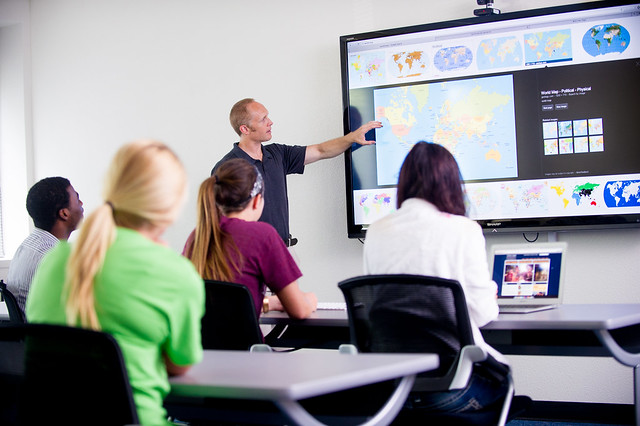1) In this first paragraph, you will select a concept on which to briefly describe. The majority of the text will be focused on your reflections, i.e., how do you think this will impact you as a teacher, how does it compare with your own experiences/thoughts, and/or how might you better use this in your own learning/teaching. PLEASE DO NOT simply reiterate what is in the reading - you need to go deeper and personalize it.
2) In the second paragraph, you will do the same as the first, but with a different concept from the chapter.
3) In the third paragraph, you will do the same as the first and second, but with a third concept from the chapter.
Conclusion - Write a concluding paragraph.
Resources:
Maloy, R., O'Loughlin, R., Edwards, S., & Woolf, B. (2013). Transforming Learning with New Technologies. 2nd Edition. Boston, MA: Pearson Education Inc.
[Other resources as applicable and be sure to use APA formatting for in-text citations, i.e., if you quote from the chapter]
*Be sure to provide hyperlink(s) and video(s) to enhance your post:
- Hyperlink - not just the URL! (Click on the word hyperlink to get the 'how to' video on how to hyperlink)
- Video - see 'how to' here
- And if you are ready to try a more advanced enhancement, add a Creative Commons licensed photograph that is relevant to your post. (Optional for first blog post, but you will want to try at some point!) Image - see 'how to' here
Please see below for an example of how to blog reflectively as required by this assignment.
-----------------------------------------------------------------------------------
Digital Badge #A - Chapter 1
First, there were a number of statistics that reference the amount of technology being used by students today (which is no surprise since it has been ubiquitous for at least a decade). However, one does not always see that technology acknowledged in the classroom. I was especially intrigued with the focus on the impact of the digital divide in considering the relative lack of "high-speed, highly interactive technologies" access, as referenced by Maloy, et al (2013, pp. 4-5). Although I can't practically solve all of those digital divide issues, there are some things I can do for my future students as noted in this article, For Low-Income Kids, Access to Devices Could Be the Equalizer. I like that the focus is on empowerment of both the teacher and the students and not on the problem alone. Anything we can do to make access more equitable seems like a worthwhile goal.
Second, I was excited to read about TPACK. It stands for Technological Pedagogical Content Knowledge and is a great way to address the idea of using technology in addition to pedagogy and curriculum for student learning and NOT focusing entirely on one or the other. I like the idea of the 'sweet spot' and hope to learn more about the concept throughout this class. The video below describes TPACK well in general terms. Though I haven't had a chance to review this webinar, it looks promising as more information on the topic.
Third, the authors challenge us to consider some of the typical technology tools of the present and how they may be used in the learning process. As shown in Figure 1.3, What Technologies Will Have the Greatest Impact on Teaching and Learning in the Next Five Years? (Maloy, et al, 2013, p. 13), I select a couple of technologies to consider. Social media is a way to connect with others and though most students might use it solely for social means, it could also be used for learning. When we consider how much learning can occur amongst us, connecting through social media broadens that focus. So we could use email and/or Facebook as a way to learn about other cultures by connecting with students in other countries, for example. Another technology that I think has been changed dramatically for students is that of digital textbooks. Instead of carrying around heavy paper textbooks, students can have access to all texts via a digital device and not only be able to read the content, but also to take advantage of online dictionaries, highlighting, and notetaking with access to easy additional web information.
In conclusion, there is much to learn about becoming a proficient teacher in the 21st century and it appears that technology will play a role that is both efficient for the teacher to be more productive, but also for students to become more creative and lifelong learners - taking learning to a deeper and more personal level. This introductory chapter, indeed, helps one to consider the textbook's title - Transforming Learning with New Technologies.
 |
| Photo credit to A&M-Commerce on Flickr |
Barsighian, T. (2013, March 13). For Low-Income Kids, Access to Devices Could Be the Equalizer. Retrieved January 3, 2015, from http://blogs.kqed.org/mindshift/2013/03/for-low-income-kids-access-to-devices-could-be-the-equalizer/
M, C. (2013, April 26). TPACK in 2 Minutes. Retrieved January 3, 2015, from http://youtu.be/FagVSQlZELY
Maloy, R., O'Loughlin, R., Edwards, S., & Woolf, B. (2013). Transforming Learning with New Technologies. 2nd Edition. Boston, MA: Pearson Education Inc.
No comments:
Post a Comment